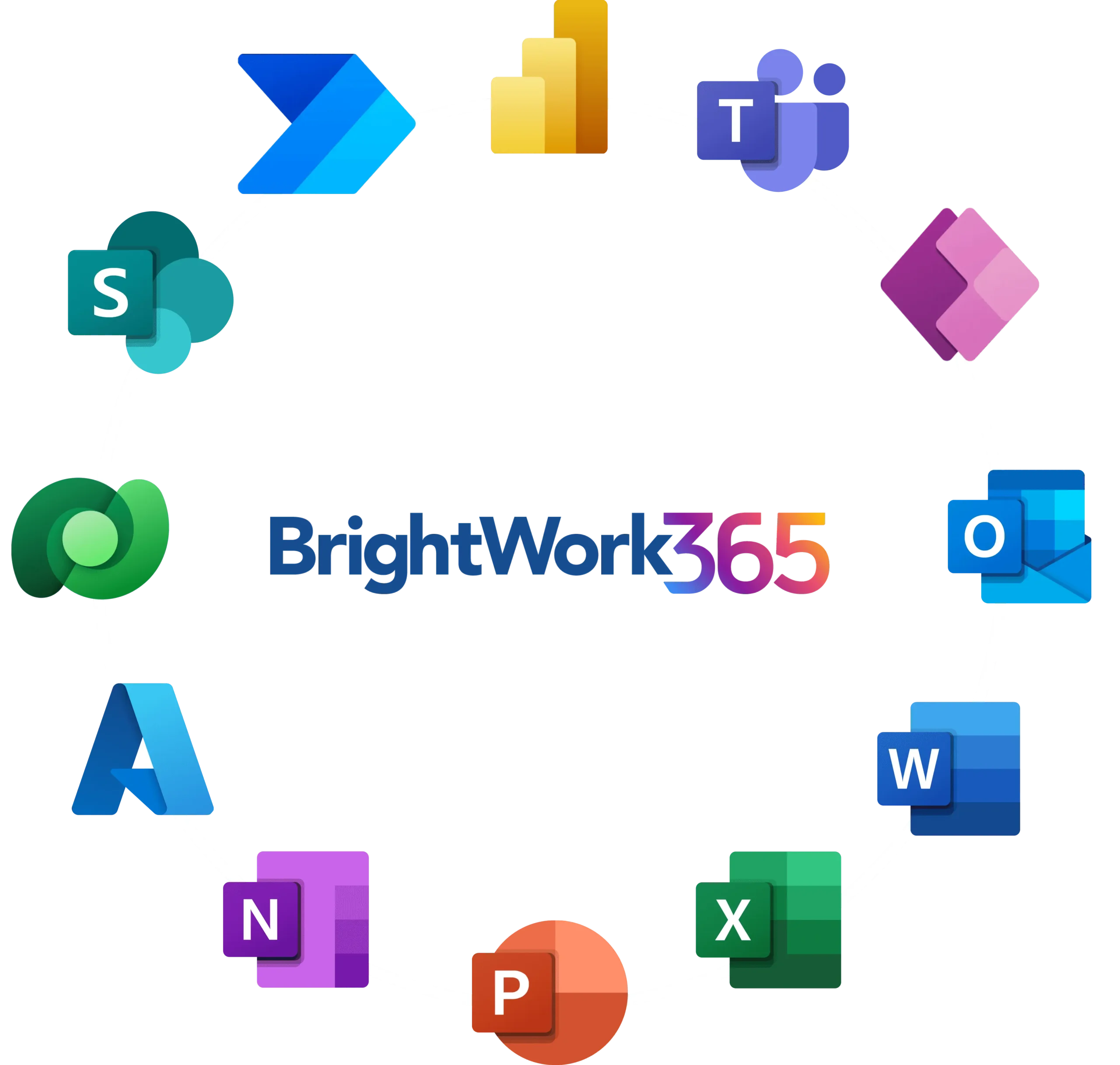Overview
Project documentation should be clear, relevant, and up-to-date to ensure all project stakeholders are on the same page.
But what does “the same page” really mean? It means that expectations, requirements, resources, and risks should be transparent and understood by everyone from the get-go.
This guide explores some essential project documents for successful projects and shows how to use the SharePoint document library and BrightWork 365 to manage this information effectively.
How Project Documents Guide Success
A solid foundation is vital for any project, often laid through essential project documents. These documents act as the roadmap, guiding you from the project’s initiation to its closure.
They help set project goals, define project scopes, allocate resources, and more. These essential documents are not just paperwork; they are strategic tools for project success.
Essential Project Templates
Project management templates offer a standardized framework that streamlines the documentation process, ensuring consistency and saving time.
Project management standardization can significantly improve work methods. Using templates ensures that all essential elements are covered, whether a project charter template or a risk log format.
Moreover, templates can also be customized to meet specific project needs, offering versatility for effective project management plans.
Adapting Documentation for Hybrid Teams
The rise of hybrid teams, combining remote and in-office employees, requires reevaluating traditional project documentation strategies.
According to research published on ResearchGate, standardizing project management improves project effectiveness, especially when team members are spread across different locations, time zones, or continents.
Cloud-based document management systems, like SharePoint Online, centralize project documents. These platforms offer real-time updates and collaborative editing, ensuring all stakeholders stay aligned, regardless of location.
Flexible Methodologies in Project Management
Project management increasingly adopts hybrid methodologies, combining Agile, Waterfall, and other approaches for greater flexibility in your project documentation.
Customizable templates can be tailored to fit these diverse methodologies, ensuring your project remains on course from project initiation to closure.
12 Essential Questions to Ask Before Starting Your Project
Before gathering or developing project documentation, you should understand the project’s purpose and required governance. It will determine the type and amount of documentation needed, as well as whether templates are available.
Here are some questions you may wish to ask yourself and stakeholders:
1. What are the Project Goals and Objectives?
Clarifying the goals ensures all project activities and resources align. It sets the stage for effective project planning and stakeholder engagement.
2. Is There a Historical Archive of Similar Projects?
If a similar project has been completed in the past, check if project documents were archived. It can provide valuable insights and potentially save time.
3. What Project Methodology Will Be Followed?
Knowing whether it’s Agile project management or another methodology will help select the appropriate project management templates and tools.
4. What Technology Will Be Utilized?
Technology affects how smoothly the project runs, from project management software to collaborative tools. Training project managers can help them effectively utilize these tools and improve team coordination.
5. Who Are the Key Resources and Participants?
Identifying key human resources and cross-functional teams is essential for project success.
6. What is the Project Budget?
Knowing the project budget is essential for effective resource allocation, including labor and operating costs. A supportive Project Management Office (PMO) can offer templates and guidance for budgeting.
7. What is the Project Timeline?
A well-defined project timeline establishes realistic project phases and deadlines, ensuring timely completion.
8. What Communication Channels Will Be Used?
Effective communication is vital for project success. Keeping project stakeholders informed is necessary, whether through status reports or formal communication plans.
9. Are There Any Potential Risks?
Identifying potential risks allows for a proactive risk management plan. Companies should frequently opt to implement standardized project management practices to mitigate risks.
10. What Are the Project Deliverables?
Knowing the project deliverables will help create a detailed project plan and set project expectations.
11. Is There a Need for Customizable Templates?
Depending on the project’s complexity, customizable document templates may be required to streamline the planning phase.
12. How Will the Project Status be Reported?
Clarify the format and frequency of project status reports to keep internal and external stakeholders updated.
Manage Projects with Microsoft 365, Power Platform, and Teams
Collaborate seamlessly from anywhere, with BrightWork 365 and Microsoft Teams

What are the 9 Essential Project Documents?
Managing projects effectively requires the right documentation to keep everything organized and clear.
This guide outlines nine essential project documents, starting with the foundational Project Business Case and ending with the insightful Lessons Learned Register.
Each document serves a unique purpose, whether defining roles with a RACI Matrix or managing changes through a formal process. Together, they provide a comprehensive framework for successfully planning, executing, and closing projects.
1. Project Business Case
This document explains the project’s purpose and outlines the goals, objectives, and desired outcomes. The business case can be a simple email from a client or a 50-page Word document with input from multiple project stakeholders.
Typically, the project sponsor is responsible for developing the business case, which can include an economic feasibility study.
You can learn more about crafting a persuasive business case for PPM software on our exclusive blog.
2. Project Charter
The project charter formally authorizes the project and gives the project manager the authority to plan, execute, and manage it.
It builds on the business case and outlines:
- Scope of the work
- Requirements
- Proposed timeline
- Budget
- Resources
- Definition of done
- Project success factors
As such, the project charter supports communication and makes stakeholder engagement easier.
If you’re looking for a free project charter template, explore our collection of free project charter templates.
3. RACI Matrix
The RACI Matrix is a great way to define and assign responsibilities. It identifies someone who is:
- Responsible
- Accountable
- Consulted
- Informed
Mapping this out helps to reduce confusion, distribute workload, and increase efficiency. To learn how to create a RACI Matrix effectively, check out this article on RACI project management.
4. Work Breakdown Structure (WBS)
A work breakdown structure (WBS) is the core of project planning and resource management while reducing the risk of scope creep.
The WBS organizes the work into manageable sections, often measured in time, for example, two weeks. The list starts with identifying required deliverables and breaking them into smaller work packages and tasks needed to reach this project objective.
The WBS ensures that every project element is noticed during the planning phase – making resource allocation much more straightforward.
5. Risks and Issues Log
This is what it says on the tin – a log of all risks and issues the project may face.
Using a standard format is recommended, including fields such as issue ID, description, impact, probability, proposed mitigation, and owner or person accountable.
Effective management of risks and issues is essential to improve project execution and handle these challenges.
6. Project Communications Plan
This plan ensures effective communication among the project team and stakeholders.
To create a project communication plan, specify communication channels, such as a weekly report, and assign responsibility to team members, such as the project manager.
7. Change Request Management
This document tracks formal changes or additions to agreed deliverables during project execution. Change management is challenging as project managers need to ensure that the change is sufficiently detailed and understood by all parties.
In most cases, change requests impact the project schedule. Remember to check and update other project documents once stakeholders authorize a formal change.
To understand how to handle them efficiently and maintain project schedules, check out our article on change requests in project management.
8. Project Schedule
The project schedule outlines the work to be completed and its timeframe. It is a baseline for the actual program, making tracking late tasks and missed milestones easier.
Automated tools like BrightWork Simple Scheduling and Microsoft Project can assist with scheduling from basic to more complex needs.
If you’re interested in using SharePoint templates to streamline project management, explore this article on SharePoint project management templates.
9. Lessons Learned Register
Lessons learned are essential to organizational project knowledge and improvement.
Although delivered post-project, the register can be worked on throughout the project life cycle. Recording findings at different project intervals will produce better quality and more factual data.
The format and detail of this document will depend on the organization’s project governance and project management culture. The entire project team should contribute to and agree on the lessons learned. Start by addressing key project questions to build your documentation.
How to Manage Project Documents with BrightWork 365
Managing your important project documents becomes a breeze with the right tools.
BrightWork 365, a cutting-edge Project and Portfolio Management (PPM) software designed for Microsoft 365, offers a centralized platform for all your project documentation needs.
Centralize Your Project Documents
Once you’ve completed the necessary project documents, it’s important to have an efficient management system in place. It ensures that your project team utilizes the correct document templates and keeps all records current.
BrightWork 365 excels in this area by allowing you to centralize your project documents effortlessly. After setting up your project templates, you can easily view, create, or upload documents through the Documents tab.
Seamless Integration with SharePoint Online
BrightWork 365 integrates smoothly with SharePoint Online. When you install the software, it automatically creates a dedicated SharePoint site and document library. All your project documents are securely stored in your SharePoint Online site.
Automated Folder Creation
With every new project you initiate, BrightWork 365 creates a new folder within this SharePoint document library. This automated feature ensures that all your project documents are well-organized and easily accessible.
Mastering Essential Project Documents and Tools for Success
In conclusion, effective project documentation forms the foundation for success, guiding every phase from start to finish. It sets clear goals, defines scopes, and aligns stakeholders while prioritizing project tasks. Standardized templates simplify the process and save time.
Advanced tools like BrightWork 365 paired with SharePoint Online take documentation to the next level. These platforms centralize files and provide features to keep them organized and accessible.
Whether you’re experienced or new to project management, this framework and these tools support planning, execution, and closure. Remember, the key to a successful project relies on thorough preparation and strong documentation.
